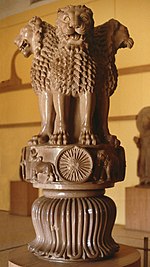This article has multiple issues. Please help improve it or discuss these issues on the talk page. (Learn how and when to remove these messages)
|
The Lion Capital Series were a series of currency notes issued after India declared its independence from Great Britain and used until the Reserve Bank of India (RBI) introduced the Mahatma Gandhi Series in 1996 with banknotes in denominations of 10 and 500 rupees, and were designed with the image of the Lion Capital of Ashoka, the National Emblem which replaced the George VI banknote series. The first banknotes printed after India achieved its independence was a 1-rupee note.[1][2]

Lion Capital Series Banknotes I
edit| Lion Capital Series | |||||||||
|---|---|---|---|---|---|---|---|---|---|
| Image | Value | Dimensions (millimetres) | Main colour | Description | Date of | ||||
| Obverse | Reverse | Obverse | Reverse | Watermark | Issue | Withdrawal | |||
| ₹20 | Orange | State Emblem of India | Old Parliament House | State Emblem of India | 1962 | 1997 | |||
| ₹10 | Fishing boat | ||||||||
| Lion Capital Series | |||||||||
|---|---|---|---|---|---|---|---|---|---|
| Image | Value | Dimensions (millimetres) | Main colour | Description | Date of | ||||
| Obverse | Reverse | Obverse | Reverse | Watermark | Issue | Withdrawal | |||
| ₹100 | 157 × 73 mm | Multicolour | State Emblem of India | Agriculture endeavour | State Emblem of India | 1975 | 1995[4] | ||
| ₹50 | 147 × 73 mm | Lilac Purple | Old Parliament House | 1981 | 1995 | ||||
| ₹20 | 148 × 62 mm | Red Purple | Konark wheel | 1975 | 2000[5] | ||||
| ₹10 | Indian peacock | 1975 | 2000 | ||||||
Gallery
editSee also
editReferences
edit- ^ "The Journey Of Indian Currency Since 1947 To The Present". Noise Break. 14 November 2016.
- ^ "The History of the Indian Currency Notes and its Evolution". Jagranjosh.com. 30 November 2017.
- ^ Reserve Bank of India. "Reserve Bank of India - Museum".
- ^ "100 Rupees, India". en.numista.com. numista.com. Retrieved 1 August 2022.
- ^ "20 Rupees, India". en.numista.com. numista. Retrieved 1 August 2022.